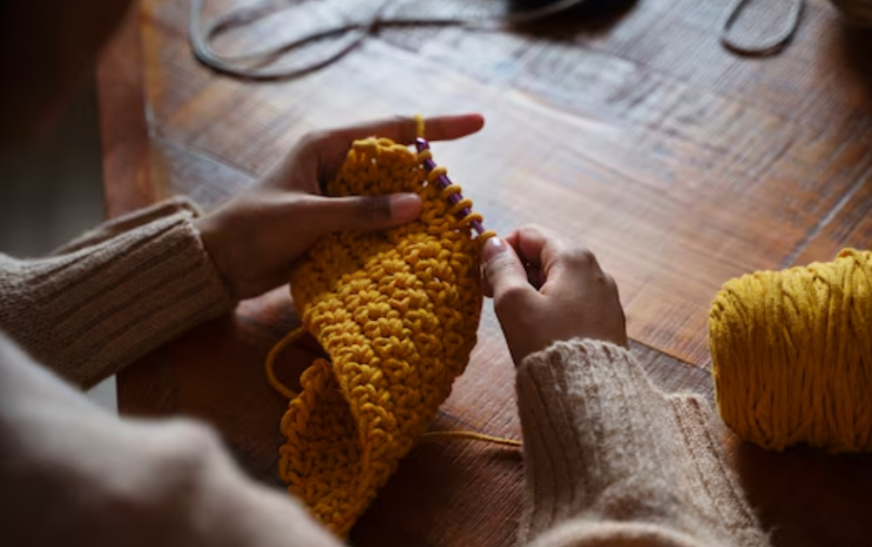Crocheting has captivated the hearts of many for centuries, offering not just a creative outlet but also a functional craft. One of the fundamental stitches in crochet is the double crochet stitch. For both beginners and seasoned crocheters, understanding and mastering the double crochet’s stitch is crucial. However, to truly elevate your crochet skills, it’s essential to explore its variants, including the half double crochet, back post double crochet’s, and double’s treble crochet. This article will provide an in-depth exploration of these stitches, complete with tips, tricks, and techniques to help you incorporate them into your projects.
What is Double Crochet?
The double crochet’s stitch is one of the most commonly used stitches in crochet patterns. It’s taller than the single crochet but shorter than the treble crochet, making it a versatile stitch that can be used in various projects, from blankets and scarves to hats and sweaters.
How to Perform a Double Crochet
- Start with a Foundation Chain: The first step in creating a double crochet’s stitch is to make a foundation chain. The number of chains will depend on your project.
- Yarn Over: After making the foundation chain, yarn over (YO), which means to wrap the yarn over the hook from back to front.
- Insert the Hook: Insert the hook into the fourth chain from the hook. The first three chains you skipped will act as the first double’s crochet’s in the row.
- Yarn Over Again: Yarn over once more, and pull the yarn through the chain. You should now have three loops on your hook.
- Pull Through Two Loops: Yarn over again, and pull through the first two loops on your hook. This leaves you with two loops on the hook.
- Pull Through the Remaining Two Loops: Yarn over one last time and pull through the remaining two loops on your hook. You have just completed one double’s crochet stitch.
- Repeat: Continue this process across the row until you reach the end. Turn your work and chain three to start a new row of double crochet’s stitches.
Understanding the Variants of Double Crochet
While the double crochet stitch is fundamental, there are several variants that add texture, height, and complexity to your crochet’s projects. Let’s delve into these variants: the half double’s crochet, back post double crochet’s, and double treble crochet.
Half Double Crochet
The half double crochet (hdc) is another essential stitch that serves as a bridge between the single crochet and the double’s crochet’s. It is shorter than the double’s crochet but taller than the single crochet, offering a dense yet flexible texture that is ideal for various projects.
How to Perform a Half Double Crochet
- Yarn Over: As with the double crochet’s, start by yarning over.
- Insert the Hook: Insert your hook into the third chain from the hook.
- Yarn Over and Pull Through: Yarn over and pull through the stitch. You should have three loops on your hook.
- Pull Through All Loops: Yarn over and pull through all three loops on the hook. This completes the half double’s crochet stitch.
- Repeat: Continue across the row, chaining two at the end of each row before turning your work.
When to Use Half Double Crochet
The half double’s crochet stitch is perfect when you want to create a fabric that isn’t too dense or too airy. It’s often used in baby blankets, hats, and garments. Its height makes it faster to work up than single crochet but provides more structure than a double crochet’s stitch.
Back Post Double Crochet
The back post double’s crochet (BPdc) is a variation of the double crochet that creates a textured, ribbed effect on your fabric. This stitch is achieved by working around the post of the stitch from the previous row rather than into the top two loops.
How to Perform a Back Post Double Crochet
- Yarn Over: Begin with a yarn over as you would for a regular double crochet’s.
- Insert the Hook: Instead of inserting the hook into the top of the stitch, insert it from the back of the fabric around the post of the stitch.
- Yarn Over and Pull Through: Yarn over and pull through the stitch. You will still have three loops on your hook.
- Complete the Stitch: Yarn over and pull through the first two loops on your hook, then yarn over and pull through the remaining two loops.
- Repeat: Continue across the row, and you will notice the ribbed texture forming.
When to Use Back Post Double Crochet
The back post double’s crochet is perfect for adding texture and depth to your projects. It’s often used in ribbing, basketweave patterns, and other designs where a three-dimensional effect is desired. You can combine BPdc with front post double crochet’s (FPdc) to create intricate patterns and textures.
Double Treble Crochet
The double treble crochet’s (dtr) is a taller stitch that is ideal for creating open, airy patterns. It’s significantly taller than the double crochet’s, making it a go-to stitch for lacework and other projects where height and openness are desired.
How to Perform a Double Treble Crochet
- Yarn Over Three Times: Begin by yarning over three times, which will give you four loops on your hook.
- Insert the Hook: Insert the hook into the fifth chain from the hook.
- Yarn Over and Pull Through: Yarn over and pull through the stitch, giving you five loops on your hook.
- Pull Through Two Loops: Yarn over and pull through the first two loops on your hook. You should now have four loops remaining.
- Continue Pulling Through Two Loops: Yarn over and pull through the next two loops. Repeat this process until only one loop remains on your hook.
- Repeat: Continue across the row, chaining four at the end of each row before turning your work.
When to Use Double Treble Crochet
The double treble crochet is ideal for projects that require height and openness. It’s commonly used in shawls, lacework, and decorative edges. Due to its height, it works up quickly, making it a favorite for large projects that require a lot of height but not necessarily density.
Combining Stitches in Patterns
One of the beauties of crochet is the ability to combine different stitches to create unique patterns and textures. By understanding how to use double crochet’s, half double’s crochet, back post double crochet, and double treble crochet’s, you can unlock endless possibilities in your crochet projects.
Creating Texture with Back Post and Front Post Stitches
By alternating between back post double crochet’s and front post double crochet, you can create stunning textured patterns. For instance, the basketweave pattern is a popular design that uses this technique. To create a basketweave pattern:
- Row 1: Work a row of double’s crochet stitches.
- Row 2: Alternate between two front post double crochet’s stitches and two back post double’s crochet stitches across the row.
- Row 3: Reverse the pattern by working two back post double crochet’s stitches and two front post double crochet’s stitches.
- Repeat Rows 2 and 3: Continue alternating rows to create the basketweave texture.
This pattern is excellent for blankets, scarves, and even garments where a textured, cozy fabric is desired.
Using Double Treble Crochet for Open Patterns
Double’s treble crochet is perfect for creating open, lace-like patterns. You can use it in combination with chains to create intricate designs. For example, a simple lace pattern using double treble crochet might look like this:
- Foundation Chain: Chain a multiple of 6 + 1.
- Row 1: Work 1 double’s treble crochet into the 6th chain from the hook, chain 2, skip 2 chains, double treble crochet into the next chain. Repeat from * across the row.
- Row 2: Chain 4 (counts as the first double treble crochet), double treble crochet into the next double treble crochet, chain 2, skip the next chain, double treble crochet into the next double treble crochet. Repeat from * across the row.
- Repeat Row 2: Continue repeating Row 2 to create a beautiful open lace pattern.
This pattern is ideal for shawls, summer tops, and other lightweight projects.
Tips for Mastering These Stitches
Crocheting is both an art and a skill that improves with practice. Here are some tips to help you master the double’s crochet and its variants:
Practice Consistency
Consistency is key in crochet. Pay attention to your tension and the size of your stitches. Uneven tension can lead to a finished project that is lopsided or has an uneven texture.
Use the Right Hook Size
Using the right hook size for your yarn is crucial. If your hook is too small, your stitches will be tight and difficult to work with. If it’s too large, your stitches will be loose and floppy. Always check the yarn label for the recommended hook size.
Count Your Stitches
It’s easy to lose track of your stitches, especially when working with larger patterns. Counting your stitches at the end of each row can help prevent mistakes and ensure your project turns out as intended.
Experiment with Different Yarns
Different yarns can produce different effects with the same stitch. Try experimenting with various yarn types, from cotton to wool to acrylic, to see how they affect the texture and appearance of your stitches.
Common Mistakes and How to Avoid Them
Even experienced crocheters can make mistakes. Here are some common errors and how to avoid them:
Skipping Chains
When working with taller stitches like double crochet’s or double’s treble crochet, it’s easy to accidentally skip chains at the beginning of a row. To avoid this, always count your chains and stitches carefully.
Twisted Chains
Twisted chains can make your project look uneven and can be frustrating to fix. To prevent this, make sure your foundation chain is straight before beginning your first row of stitches.
Incorrect Tension
Incorrect tension is a common issue that can lead to a finished project that is either too tight or too loose. Practice finding the right tension that works for you, and stick with it throughout your project.
Conclusion
Mastering the double crochet stitch and its variants opens up a world of possibilities in crochet. From the sturdy and versatile double crochet’s to the textured back post double’s crochet’s and the airy double treble crochet, these stitches are essential tools in any crocheter’s toolkit. By practicing these stitches and incorporating them into your projects, you can create beautiful, unique pieces that showcase your skills and creativity.
Whether you’re crocheting a cozy blanket, a delicate shawl, or a textured scarf, the double crochet’s and its variants offer endless opportunities to express your creativity. So grab your hook, choose your yarn, and start experimenting with these stitches today. The world of crochet is at your fingertips!
Read: The Ultimate Guide to Finding the Perfect Loft for Rent: What You Need to Know








